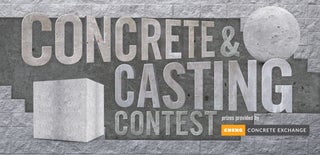Introduction: Concrete Shelves
Concrete furniture looks amazing and is really cheap to make. A year ago I decided to make a concrete garden bench. This was a great success and my hands were itchy to make something else out of concrete. My girlfriend needed some shelves for displaying her cameras. A new project was born: concrete shelves!
If you like this project please vote for me in the shelving or concrete & casting contest or maybe even buy a shelf in my Etsy shop.
Step 1: Materials & Tools
Materials:
- Shuttering plywood:
To make your mold you need a waterproof plywood with a smooth surface. Shuttering plywood is a material that's designed to make molds. It's got a very smooth surface and is water resistant. It's also expensive. I was planning on reusing the mold therefore shuttering plywood was the way to go. When you are planning on making only one shelf, melamine board is a cheap alternative.
- Concrete (levelling cement)
For this project I didn't use regular concrete but I used levelling cement. In some experimentation earlier I figured out that levelling cement is really nice to work with. Levelling cement gives a really smooth surface and has a fine grain which makes sanding a lot easier. Another advantage is that it cures really fast, you can demold in approximately 4 hours. For this project you can also use regular concrete.
- 3D-printed part (see step 5)
- Concealed shelving brackets Buy
- Magnets 10mmx10mm Buy
- Tube with a 12mm inner diameter (I used 15mm heating tube)
- Release agent: silicone spray, petroleum jelly, WD40, etc.
- 4x M6 nuts and bolts
- 4x M6 coach screw
- 4x M6 coach screw
- Polymorph plastic (optional)
- Concrete coloring (optional)
Tools
- Power drill
- Hammer
- Iron saw
- Mixing bucket
- Regular carpentry and measuring tools
- Old sander (optional)
Step 2: Design
The shelf has a minimalistic rectangular shape. The size of the shelf is 22,5cm x 15cm x 5cm.
The weight of the shelf is 3kg. I therefore chose to use two sturdy brackets. Inside the shelf there are two sliding tubes which will fit the bracketpins neatly. In the concrete are two embedded magnets. Those magnets will cling on to the brackets and will keep the shelf close to the wall.
A lot of people are afraid of the weight but don't be! The brackets can hold aprox. 10 kg each so the 3kg shelf isn't a problem.
Step 3: Making the Mold
The mold excist of 6 pieces of shuttering plywood, 5 for creating the mold and 1 to hold the the brackets in place. Because I'm clamping the mold it's very important to cut every piece exactly in the right size. I let my local hardwarestore do it but be sure too cut all the pieces with the same size at once.
The holes in the sixth piece of plywood are drilled in the way the brackets will be eavenly distributed in the shelf. In between the bracketpins will be a spacing of 11 cm. The holes are drilled 7 mm to be used for the m6 bolts.
If you want to reuse to the shuttering plywood it's recommended to seal the end faces. I forgot but in the future I will definitely seal them.
This is the size I used but off course you can choose your own size shelf.
Step 4: Slide Tubes
The bracketpins have a diameter of 12mm. The sliding tubes have to fit neatly on to the pins to ensure te shelf will hang in a 90 degree angle with the wall.
Cut the tubes to 12 cm each. After this you have to be sure that concrete can't enter the bottom part of the tube. I chose to hammer the end flat. In this way concrete can't enter the tube and the flat side of the tube anchors the tube in the concrete.
Step 5: 3D-printed Mold
On the back of the shelf there has to be a void to house the bracket and the bolt. To create the void I designed a 3D-printed piece. The angles in the piece are designed for easy unmolding.
Unfortunately I don't have access to a 3D-printer. I used 3dhubs.com to print the two pieces. The cost for the two pieces was 20 dollars. When the piece came out the printer it was a little rough. Too ensure that the piece will come out of the mold easily I sanded it down with fine sandpaper. In the picture you can see the difference between a sanded and a non sanded piece.
The piece is designed to be 3mm above the surface of the concrete. The bracket has a thickness of 5 mm which adds up to a total of 8mm. I used M10 bolts to create this gap of 8mm (see next step), but you can use whatever you want with a 8mm thickness.
Polymorph plastic
Before using the 3D-printed part I used polymorph plastic to make the void. I covered the bracket with polymorph plastic and poured the concrete. When the concrete was cured I made the polymorph plastic warm and the bracket came out easily. This method will work but will take some time and won't give you a nice backside of the shelf.
Attachments
Step 6: Pouring Concrete
1. Apply release agent
For the shuttering plywood I used siliconespray as a mold release. Just spray it at the surface and spread evenly. The 3D-printed pieces are treated with some petroleum jelly.
2. Clamp down the mold pieces
Clamping down the mold pieces is quite easy but be sure everything is set up nice and straight.
3. Set up the brackets
Start with installing the brackets and the 3D-printed piece onto the plywood with the M6 bolts. Because the holes are drilled 7mm there is a bit of room to align the two brackets. By placing the piece on a flat surface you can feel if it wobbles. When there's no wobble you are sure that the two brackets are at the same height (see picture).
4. Place the sliding tubes and magnets
To secure the sliding tubes I use a piece of tie wrap that fits between the tube and the bracketpin. In this way the sliding tubes are secured. The magnets are easy to pop on 2 of the bolts.
5. Mix the concrete following the instructions on the bag.
When mixing the concrete it is easier to calculate the amount of water first then add the concrete to the water in stead of adding water to the concrete. This way it is a lot easier to mix the two parts together. You can choose to add coloring; never add more then 5% coloring powder or it can effect the strenght of your concrete.
6. Pour the concrete in the mold
Firts pour the concrete in the mold without the brackets. When it's almost full you can place the brackets and poor the remaining with a funnel.
If you're using regular concrete you want to tap or vibrate the mold to release air bubbles. You can use an old sander to vibrate the mold. I found out this wasn't neccesary when using levelling cement.
7. Align the brackets
Be sure the brackets are placed parallel to the surface of the shelf. You can do this by aligning the plywood piece to the mold (see picture).
Step 7: Demolding
When you do everything right demolding is a really easy step. The brackets and moldpieces should come right off.
I always demold after a short period of time, for the levelling cement I only wait for four hours. The levelling cement is hard enough to unmould but still a bit soft. In this way the shelf is really easy too sand.
The backside of the shelf won't be totally flat. Use a flat surface and some sandpaper to flatten the backside.
After demoulding you can clean up the moldpieces and use them again.
Step 8: Final Product
I chose to paint the shelves with a transparant polyurethane floor coating. This will give the shelf a smooth finish but will also protect against stains.
To fix the brackets I used coach screws. When hanging the shelf you first have to mount the two brackets but only fix one of them. Then put the shelf in place and tighten the remaining coach screw with a spanner while the shelf is in place. In this way the brackets will align perfectly.
My girlfriend loves her new shelves and this works for me too because "A happy wife makes a happy life" :)
Enjoy your concrete shelf!

Participated in the
Shelving Contest

Participated in the
Concrete and Casting Contest














